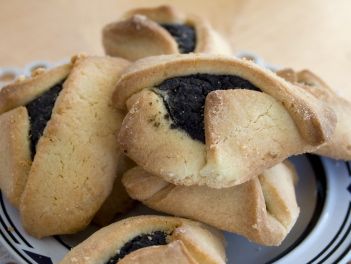
reference-image, l
(post, Ronnie Fein)
Like so many other Jewish holidays, Purim — which begins at sundown on Monday, March 9 — celebrates a victory over an enemy who tried to destroy our people. At the time of the ancient Persian Empire, so the story goes, an advisor to King Ahasuerus named Haman was bent on destroying all the Jews. But Queen Esther, who was married to the king, and her cousin Mordechai appealed to Ahasuerus for help, and Haman was hanged instead. Spared from doom, Mordechai called upon the Jews to forever celebrate the happy turn of events by feasting and making merry. And indeed we do, which is why we become such a raucous bunch on Purim. According to tradition, adults are supposed to drink so much that they can’t tell the difference when two phrases are called out: “Cursed be Haman!” and “Blessed be Mordechai!” Well, wine and other sorts of booze may abound on Purim, but most of us are too busy taking our kids to parties or to synagogue, where they can run around, make a racket, and twirl “groggers” — the kind of really loud noisemakers some people use on New Year’s Eve. In the synagogue, the Book of Esther is read aloud, and every time Haman’s name is mentioned (if you can hear anything over the noise), everyone stomps their feet, and some people hiss and boo. Most of the kids dress up in costumes (usually the girls are Queen Esther and the boys are Ahasuerus). [%image reference-image float=left width=350 caption="Hamantashen is traditional at Purim, but scones make nice mishloach manot."] Most people who've heard of Purim know that it’s not only earsplitting but is also marked with the eating of hamantashen, triangular-shaped, fruit-filled, cake-like cookies. They're representative of the kind of three-cornered hat Haman is said to have worn, so in a kind of delicious justice, we get to feast on something sweet and wonderful, and destroy the enemy in the process. But most people probably don’t know about mishloach manot, a terrific little Purim tradition of sending food to friends and gifts to the poor. In some places this custom has become big business; people send gorgeous baskets filled with catered food, pastries, wines, breads, chocolates, and other delectables. But mishloach manot isn’t meant to be a competitive, one-upsmanship thing. It’s intended as a thank-you for survival and victory, and as a show of friendship and community. It’s another way to show your friends you are thinking about them, and it doesn’t have to cost a lot of money. Beautiful baskets aren’t necessary; neither are fancy ribbons or bows. [[block(sidebar). h1.Featured recipes]] The custom is to give two items of ready-to-eat food to each person. I sometimes give two variations of a recipe: lemon scones and herb scones, for example, or banana bread and lemon tea bread. Sometimes I make two kinds of cookies (usually butter cookies and chocolate chippers). But in the past I have also sent coordinating gifts: homemade biscuits with store-bought jam, soup with cornbread, hummus and homemade pita crisps. You’re supposed to send the food gifts by way of your children, but that’s not really feasible whether you live in the city or the suburbs. I drive everything over to the four or five people I give gifts to. I always make extra food just in case our mailman, Chris, has a large package that won’t fit in the mailbox and has to deliver it in person. Or the washing-machine repairman is coming, or the UPS guy rings the bell. None of them is Jewish, but hey, goodies are goodies, and it’s all about friendship and community.

reference-image, l